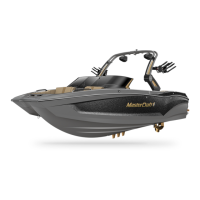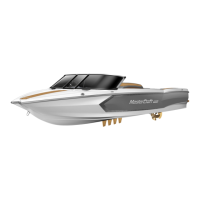CHANGE TRANSMISSION FLUID
In order to thoroughly drain all the old transmission fluid, you will
need to run the boat engine for a period of at least five minutes. Do not run
your engine without it being in water, unless you have the appropriate,
professional hook-up available to protect the engine and drive-train com-
ponents. If this is not available to you and if you do not wish to run your
boat in the water and then remove it for this procedure, have your
MasterCraft service technician perform this function because he has the
proper equipment to protect your engine while it runs out-of-water.
Step 1: Ensure the engine is OFF and the engine safety starting switch is
disconnected. Be certain that the throttle/shift control lever is in neutral. The
transmission fluid must be warmed up.
Step 2: Open the engine compartment and locate the transmission.
Step 3: Remove the transmission dipstick.
Step 4: Use a suction pump through the transmission diptick opening to
remove the fluid from the transmission casing.
Step 5: On a 1:1 transmission, the filter is located beneath the transmis-
sion housing.
On a Power Slot transmission, the filter is accessed through a round plug
on the side of the transmission housing.
On a V-drive transmission the filter is accessed through a round plug on
the side of the transmission housing.
Step 6: On a 1:1 transmission, remove and clean the screen. When re-
installing, use and ensure that the gasket is placed correctly, after replacing
the filter.
Step 7: The following chart shows what type of fluid is needed for your change. (If your transmission is not listed here,
check with your MasterCraft dealer for specifications on capacities and recommended fluid type.)
Transmission Model Ratio Capacity Fluid Type
ZF Hurth in-line 450D 1:1 1.7 qt. (1.6L) Dexron II, III or MECON
ZF Hurth in-line 450A 1.5:1 2.12 qt (2L) 15W40 motor oil
ZF Hurth in-line 630A 1.5:1 4.2 qt (4L) 15W40 motor oil
ZF Hurth V-drive G30V 4.2 qt (4L) 15W40 motor oil
Note: Access to the transmission fluid filters is somewhat difficult in some models; nonethless, this maintenance is vital to
long-term, trouble-free boating. If you feel that you cannot complete this process, contact your dealer.
CHECK THE ENGINE MOUNTS
Step 1: Ensure the engine is OFF and disconnect the engine safety starting switch. Be sure
that the throttle/shift control lever is in neutral. The engine must be cool.
Step 2: Open the engine box and locate the four motor mounts.
Step 3: Check the tightness of the mounting hardware and adjustment lock-nuts. Tighten
any loose hardware securely.
2005 MASTERCRAFT OWNERS MANUAL–PAG E 16-14

